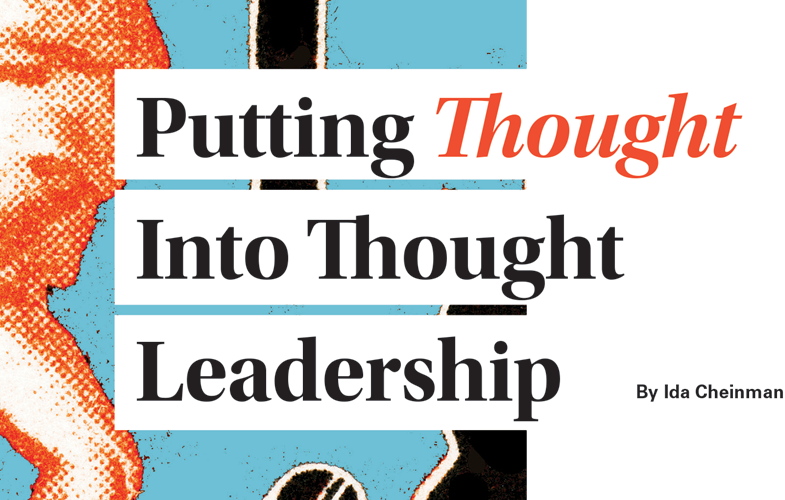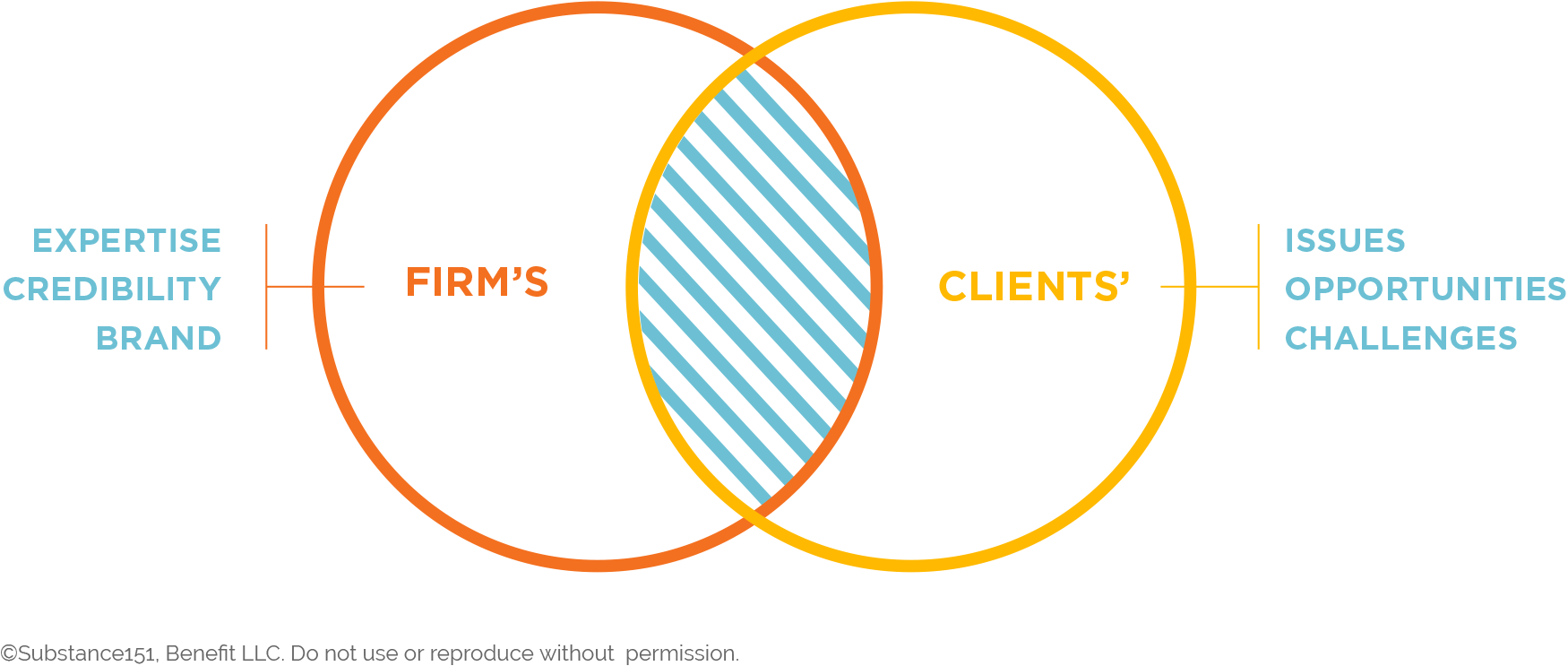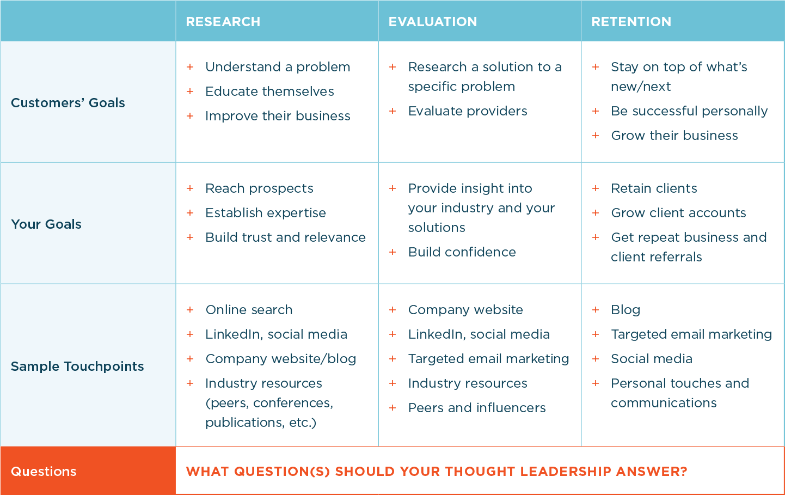This article was first published in the Marketer – Journal of the Society for Marketing Professional Services (SMPS).

Image: ©Marketer, The Journal of the Society for Marketing Professional Services
You’ve probably heard the expression “helping is the new selling.” Content marketing focuses broadly on using content to educate prospects – answering their questions, helping them do their jobs, and, ultimately, helping firms win business.
Thought leadership is more than showing off your knowledge or being helpful. Not every subject matter expert (SME) can be a thought leader, and not all educational content is thought leadership.
Thought leadership must offer a new or different perspective that challenges audiences’ assumptions about the subject or opens their eyes in some way.
“Great thought leadership should help senior executives shape their thinking and make better decisions.”—Michael Reeves, Global Brand & Marketing, EY
With many A/E/C firms offering similar services, thought leadership is an opportunity to differentiate your firm by showing prospects how you can overcome their challenges and advance their goals.
Thought leadership takes the conversation beyond the scope of your firm’s technical capabilities or the services it provides. It helps connect your firm’s offerings to the business value of solving its customers’ problems – something that 85% of B2B marketers fail to do.1
And it does this before prospects are ready to discuss square feet or stormwater drain design. It engages prospects very early in the research process, helping them understand how your firm is the best choice long before there’s an RFP.
Today’s prospective clients rely on their own research and digital sources (search engines, firm and industry websites, and social media) significantly more than advice from a company representative or sales professional when making decisions. Clients do their homework!
Your firm’s brand visibility and reputation as a leader in its field have become a critical part of the buyer’s research and selection process and, as a result, of your firm’s marketing. According to Grist’s “Value of B2B Thought Leadership Survey 2020,”2 the top direct actions taken by executives when a company’s thought leadership hit the mark are:
With long sales cycles and a complex decision-making process, your firm needs to continually have conversations with prospects, building credibility and trust over time. Thought leadership signals that your firm and its experts can be trusted. In fact, 82% of business decision-makers state thought leadership increased their trust in a company.3
However, credibility and trust don’t result from bait tactics; marketing gimmicks; or mediocre, superficial content. They grow out of a deep understanding of your customers and an authentic desire to help them make difficult business decisions in today’s fast-changing and complex world.
In the 2019 Edelman-LinkedIn B2B Thought Leadership Impact Study4:
According to the same survey, 60% of decision makers stopped following an organization after reading thought leadership. The biggest complaint related to thought leadership is that content is superficial or lacks insight.
Done right, thought leadership creates measurable positive business outcomes. Done wrong, it damages your brand and your firm’s reputation.
Deciding what to talk about can be overwhelming! The aforementioned Grist study found that decision makers consume thought leadership to make better decisions (65%), stay informed of emerging trends (41%), and get answers to the most pressing questions (31%).
Your topics and content should reside at the intersection of your firm’s expertise and what your customers care about. To find opportunities where your brand can own or lead timely conversations, determine the overlap between what your firm wants and can credibly talk about and what customers need and want to know.

What your customers need and want is help staying on top of industry trends and solutions in response to those trends. Your thought leadership must deliver personal value to decision-makers within your clients’ organizations.
Begin by asking: “Why are we doing this?” What would we like thought leadership to help our firm accomplish? Then take your business and marketing goals into account, using marketing research to inform your approach.
Although you shouldn’t sell through thought leadership, it must align with your offerings and, like any marketing activity, create positive and measurable business outcomes for your firm. Use thought leadership to:
Use business intelligence to inform your thought leadership strategy, enabling you to make better, more strategic, and more effective decisions.
1. Customer Research. Statistically, there are between six and 10 decision makers involved in complex B2B sales. These become the basis for your buyer personas.
Begin with three to five personas and focus on the core attributes, behaviors, buying process, and key motivators. Use this information to identify thought leadership topics, channels, and formats for each persona at different stages in their journey.

Thought leadership is most effective in the early stages of the buyer’s journey (research and evaluation) and client relationship management.
During the Research stage, prospects are looking for self-education, and they aren’t ready to evaluate specific solutions or solution providers. Thought leadership content allows you to reach audiences that aren’t presently aware of your firm, helping meet the first two objectives mentioned above: increase brand visibility and get in front of new customers.
In the Evaluation phase, your prospects are already aware of your firm and considering it for an opportunity. Your focus should be on providing insight into your industry and the solutions your prospects need, showcasing your firm’s unique expertise and approach to problem-solving.
The thought leadership content for the Client Retention phase will be similar to the first two stages of the buyer’s journey. Focus your insights on helping your customers do their job, make better decisions, and stay informed of emerging trends and opportunities. Your thought leadership should add value and help strategically grow existing client accounts.
2. Competitive Research. Understanding what your competitors are doing will help identify any gaps your thought leadership can fill – or at least join a conversation with your own point of view.
To evaluate your competitors’ thought leadership, create a matrix that captures their topics, the types and formats of their published content, channels, and frequency.
Document what you find on each company’s public website, blog, and social media. Note if their experts present at conferences, webinars, podcasts, or do guest blogging. Identify any industry publications in which competing firms and their experts appear.
Analyze what you’ve collected to identify any gaps in the conversation that create opportunities for your firm to stand out.
3. Business and Industry Research. This type of research helps you understand what affects your customers’ markets, stay ahead of your industry trends, and identify where your unique expertise can add value.
Primary research in itself is a highly valuable thought leadership strategy. However, if you don’t have the capability or capacity to conduct primary research, use existing research from trusted sources.
Local and global research companies publish hundreds of reports every year – McKinsey & Company, Gartner, Dodge Data & Analytics, PSMJ, and Think with Google, just to name a few.
LinkedIn industry groups offer a valuable resource for understanding what your customers are talking about and what questions they’re asking.
Although the goal is to achieve a collective position of your firm as a thought leader, you can’t get there without the individual contributions of your experts.
Thought leadership is a team sport and a shared responsibility between SMEs and marketing. The exact balance and roles will depend on many factors, including the size of your firm and its marketing team. Before you start:
Take into account that not everyone who is good at their job is a thought leader. Also, consider that some people may be a better fit to author an article, while others could be better at participating on a panel.
It helps when SMEs have high visibility and large, valuable networks that will help increase the reach and impact of your thought leadership exponentially.
However, this is also an opportunity for younger technical professionals to build visibility, credibility, and their personal brands. And they’re often more eager to help marketing teams, as they work to prove themselves and become more visible – within the firm and the industry.
An SME can provide input, write the first draft, or develop content from start to finish. But it’s marketing’s responsibility to create a brief that outlines the goals, persona(s), distribution channels and formats, and any other details to frame research, writing, and promotion.
Once a piece is developed, help SMEs share their content – provide scripts and graphics for social sharing and encourage them to send it directly to prospects and clients.
Make sure that once content is published, you collect all positive feedback and communicate it back to your SMEs. It will be much easier to engage them again if their efforts are getting noticed and recognized!
It took a lot of work to get to this point, and having a distribution and promotion plan is as important as creating content. The formats and channels will depend on the goals, topic, and other factors, such as where the intended audiences for this content congregate.
Determine the most effective format and channel mix for each piece. Although it’s likely to always include your blog and LinkedIn, consider other channels and formats that showcase each piece and reach your audiences most effectively.
Develop a promotional schedule. Create a calendar for the initial rollout campaign and decide when and how often you’ll be promoting this content over time. Is this content evergreen? Then put it into a regular rotation, making sure to update it as needed.
Produce channel-specific assets, graphics, and scripts. Providing easy-to-use tools simplifies sharing for employees who are less comfortable with social media. It also ensures that all messages are consistent and on-brand and include proper hashtags and mentions.
Amplify each piece. Identify a select group of company leaders and client-facing employees whose expertise is similar or who have exposure to the type of prospects and clients you want to reach. Make sure you provide thought leadership content to all client facing teams in a format(s) that makes it easy to share with their prospects and clients. Also make it part of pitches and presentations.
Repurpose and leverage content. Find creative ways to extend the shelf life of thought leadership content. For example:
Considering the time and effort required for managing a thought leadership program, you must be able to show it’s working. Demonstrating success will help justify time and resources spent and ensure internal support for growing and expanding the program in the future.
1. Identify what to track. Your metrics must align with the business goals you defined at the early stages in the planning process.
2. Set up analytics and reporting. Take advantage of free platforms, such as Google Analytics and Looker Studio (formerly Google Data Studio), as well as analytics built into your social media and email marketing platforms.
3. Analyze what you collect. Collecting data is easy – take time to understand what you’ve collected and what that data really tells you.
4. And, finally, turn that information into actionable insight. Knowledge without action doesn’t equal result – use the information and insight to continually improve the impact of your firm’s thought leadership program.
Even though your firm’s SMEs are at the core of its thought leadership, it’s not just about big ideas or insight. Your thought leadership program must provide business value. Marketing plays a critical role in helping your firm realize the full potential of thought leadership to influence customers’ thinking and actions – engaging more ideal clients and winning more business.
1“The Sophisticated Marketer’s Guide to Thought Leadership,” LinkedIn Marketing
2“Value of B2B Thought Leadership Survey 2020,” Grist
3“What Is Thought Leadership? And When You Should Use It?,” Michael Brenner, Marketer Insider Group, May 23, 2019
4“Seizing the Untapped Potential of Thought Leadership,” 2020 EdelmanLinkedIn B2B Thought Leadership Impact Study